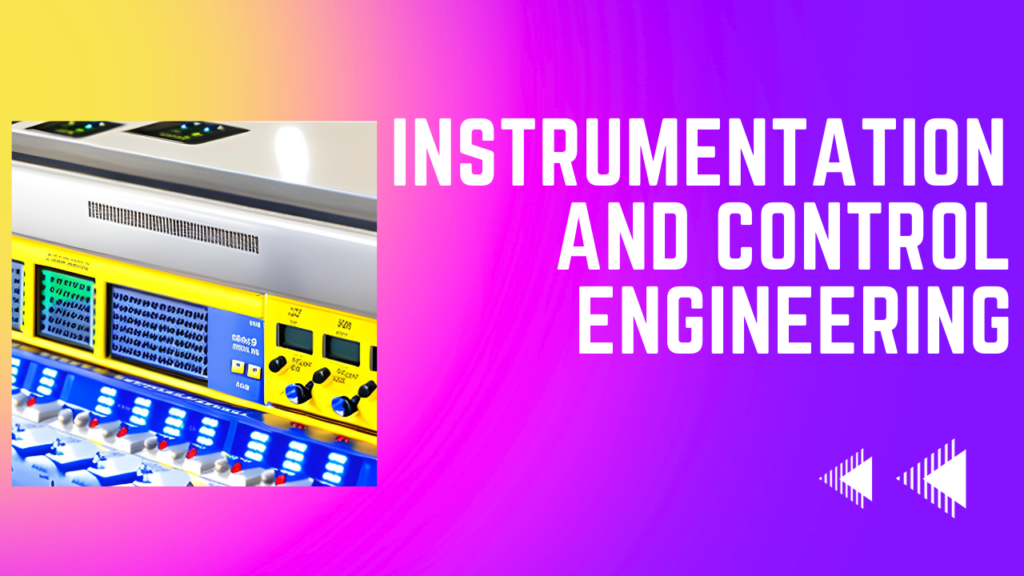I. Introduction
The Oil & Gas Industry is a cornerstone of the global economy, supplying energy and raw materials to power countless sectors. The safe and efficient extraction, processing, and transportation of these valuable resources are paramount. Instrumentation and Control Engineering (ICE) is a critical discipline that ensures these operations run smoothly, efficiently, and most importantly, safely. In this comprehensive guide, we delve into the world of ICE, exploring its history, basic functions, applications, advantages, and associated standards within the Oil & Gas Industry.

Table of Contents
Do not miss the detailed course 7 Modules of Piping Codes & Standards
Enrollment link
II. Brief History
The Roots of Instrumentation and Control Engineering
Instrumentation and control systems have a rich history that has evolved alongside the Oil & Gas Industry. The roots of ICE can be traced back to the early 20th century when the industrial revolution was in full swing. As industries such as oil refining and petrochemicals grew, the need for precise measurement and control became increasingly evident. Early systems were rudimentary, relying on basic mechanical devices and manual control. However, as technology advanced, so did ICE.
Milestones in ICE Development
The field of ICE has witnessed several pivotal milestones:
1. Emergence of Pneumatic Control (1920s)
Pneumatic control systems, which relied on compressed air, were among the earliest forms of automation. They provided a way to control processes remotely and laid the foundation for more sophisticated systems.
2. Introduction of Electronic Control (1940s)
The advent of electronic components and transistors in the mid-20th century revolutionized ICE. Electronic controllers allowed for more precise and responsive control of industrial processes.
3. PLCs and DCS Systems (1960s-1970s)
The 1960s and 1970s saw the rise of Programmable Logic Controllers (PLCs) and Distributed Control Systems (DCS). These digital systems introduced a new level of automation and control, greatly enhancing efficiency and safety.
4. SCADA Systems (1980s)
Supervisory Control and Data Acquisition (SCADA) systems emerged in the 1980s, enabling real-time monitoring and control of remote facilities. This technology played a crucial role in the Oil & Gas Industry, allowing for the management of vast and geographically dispersed operations.
5. Advanced Process Control (APC) and Industry 4.0 (2000s-Present)
In recent decades, ICE has continued to evolve with the integration of Advanced Process Control (APC) and Industry 4.0 concepts. These advancements leverage artificial intelligence, data analytics, and the Internet of Things (IoT) to optimize processes and predict equipment failures.
III. Basic Function and Working Principle
Understanding the Fundamentals
At its core, ICE involves the use of instrumentation and control systems to measure, monitor, and regulate various parameters within industrial processes. These parameters can include temperature, pressure, flow rate, level, and composition. The primary objective is to ensure that processes operate within specified limits, maintaining safety, efficiency, and product quality.
Working Principle of Instrumentation
Instrumentation relies on sensors and transmitters to collect data from the process. These sensors convert physical variables, such as temperature or pressure, into electrical signals. Transmitters then send these signals to controllers for analysis and action.
Control Systems in Action
Control systems receive input from sensors and use algorithms to determine the appropriate actions required to maintain desired process conditions. These actions are executed through actuators, which can adjust valves, pumps, motors, or other devices.
IV. Application of Instrumentation and Control Engineering in Oil & Gas
The Versatility of ICE in the Industry
Instrumentation and control engineering find wide-ranging applications within the Oil & Gas Industry, contributing to its safety, efficiency, and profitability. Let’s explore some key areas where ICE plays a crucial role:
1. Exploration and Drilling
In the upstream sector, ICE is instrumental in managing drilling operations. It monitors parameters such as well pressure, drilling fluid flow, and equipment status. Automatic drilling systems, guided by ICE, ensure precise wellbore placement while minimizing the risk of blowouts.
2. Production and Refining
Instrumentation and control systems are essential in optimizing production processes and refining operations. They monitor the flow of crude oil, gas, and petrochemicals, maintaining product quality and safety. Automated control loops adjust process variables in real-time, increasing efficiency and minimizing waste.
3. Pipeline and Transportation
The transportation of oil and gas through pipelines demands continuous monitoring and control. ICE systems detect leaks, pressure variations, and temperature fluctuations, allowing for rapid response to potential hazards. Additionally, control systems manage the flow of products through pipelines, ensuring reliable transportation.
4. Safety Systems
Safety is paramount in the Oil & Gas Industry, and ICE is a key player in ensuring it. Emergency shutdown systems (ESD) and fire and gas detection systems rely on instrumentation and control to rapidly respond to critical situations, safeguarding personnel and assets.
5. Environmental Compliance
ICE also contributes to environmental compliance by monitoring emissions, effluents, and waste disposal. It helps industries adhere to strict regulations, reducing their environmental footprint.
6. Maintenance and Asset Management
Predictive maintenance, enabled by ICE, reduces downtime by identifying equipment issues before they lead to failures. Condition monitoring systems track the health of machinery, allowing for timely maintenance or replacement.
Do not miss the detailed course 7 Modules of Piping Codes & Standards
Enrollment link
Case Study: SCADA in Oil & Gas
A prime example of ICE in action is the implementation of SCADA systems in the Oil & Gas Industry. SCADA, which stands for Supervisory Control and Data Acquisition, is a technology used to monitor and control remote facilities. In the oil and gas sector, SCADA systems are employed to oversee vast networks of pipelines, wells, and storage facilities.
How SCADA Works
SCADA systems consist of several components:
- Remote Terminal Units (RTUs): These devices are installed at remote sites and collect data from sensors and equipment.
- Master Terminal Units (MTUs): Located at a central control center, MTUs receive data from RTUs and provide operators with real-time information.
- Communication Infrastructure: SCADA relies on communication networks, such as satellite or cellular, to transmit data between RTUs and MTUs.
Benefits of SCADA
SCADA systems offer several advantages in the Oil & Gas Industry:
- Real-time Monitoring: Operators can monitor the status and performance of assets in real-time, allowing for immediate response to issues.
- Data Logging: SCADA systems record vast amounts of data, which can be used for analysis, reporting, and predictive maintenance.
- Remote Control: Operators can remotely control equipment, valves, and pumps, reducing the need for on-site personnel.
- Safety: SCADA systems enhance safety by providing early detection of leaks, equipment failures, and abnormal conditions.
V. Advantages & Disadvantages (Table)
| Advantages of ICE in Oil & Gas | Disadvantages of ICE in Oil & Gas |
|---|---|
| 1. Enhanced Safety | 1. Initial Installation Costs |
| 2. Improved Efficiency | 2. Maintenance Complexity |
| 3. Quality Assurance | 3. Vulnerability to Cyberattacks |
| 4. Reduced Environmental Impact | 4. Skilled Workforce Requirements |
| 5. Predictive Maintenance | 5. Compatibility Challenges |
VI. Associated Codes & Standards (Table)
| Code/Standard | Description |
|---|---|
| API 500 – “Recommended Practice for Classification of Locations for Electrical Installations at Petroleum Facilities Classified as Class I, Division 1 and Division 2” | Provides guidance on electrical installation classifications in hazardous locations. |
| ANSI/ISA-5.1 – “Instrumentation Symbols and Identification” | Defines symbols and identification codes for instrumentation in process control diagrams. |
| IEC 61511 – “Functional Safety – Safety Instrumented Systems for the Process Industry Sector” | Outlines requirements for the design, installation, and operation of safety instrumented systems. |
| NFPA 72 – “National Fire Alarm and Signaling Code” | Covers fire alarm and detection systems, which are crucial for safety in Oil & Gas facilities. |
| ISA-95 – “Enterprise-Control System Integration” | Provides guidelines for integrating business systems with control systems in the Oil & Gas Industry. |
VII. 5 FAQs
Q1: What is the role of instrumentation and control engineering in ensuring safety in the Oil & Gas Industry?
A1: Instrumentation and control engineering plays a vital role in safety by monitoring critical parameters, detecting anomalies, and triggering automatic shutdowns or alarms when necessary.
Q2: How do ICE systems contribute to environmental compliance in the Oil & Gas Industry?
A2: ICE systems monitor emissions, effluents, and waste disposal, helping industries adhere to environmental regulations and minimize their impact on the environment.
Q3: What are the key challenges in implementing ICE in the Oil & Gas Industry?
A3: Challenges include high initial installation costs, the complexity of maintenance, vulnerability to cyberattacks, the need for a skilled workforce, and compatibility issues with legacy systems.
Q4: How does predictive maintenance, facilitated by ICE, benefit the industry?
A4: Predictive maintenance uses data from ICE systems to identify equipment issues before they lead to failures, reducing downtime and maintenance costs.
Q5: What are the emerging trends in instrumentation and control engineering in the Oil & Gas Industry?
A5: Emerging trends include the integration of artificial intelligence, data analytics, and the Internet of Things (IoT) for advanced process control and predictive maintenance.
Conclusion
Instrumentation and control engineering are indispensable components of the Oil & Gas Industry, ensuring the safe, efficient, and environmentally responsible operation of facilities. From its humble beginnings to the integration of cutting-edge technologies, ICE has continuously evolved to meet the industry’s ever-changing demands. As the sector embraces Industry 4.0 and beyond, the role of ICE will only become more pivotal in shaping the future of energy production and distribution. Understanding the fundamentals of ICE is essential for professionals in the Oil & Gas Industry, as it empowers them to navigate this complex landscape and drive innovation in a critical field.
This article has provided an extensive overview of ICE, its history, applications, advantages, and standards in the context of the Oil & Gas Industry. With a foundation in ICE, industry professionals can contribute to the sector’s sustainability and growth, ensuring that it continues to power the world for generations to come.
Recommended courses (Published on EPCLand)
- Basics of Piping Engineering
- Piping Layout Engineering
- Piping Material Engineering
- Piping Stress Analysis
- Complete Course on Piping Engineering
- Material Requisitions
- Piping Material Specifications
- Valve Material Specifications
Don’t miss the published articles on following:
Do not miss the detailed course 7 Modules of Piping Codes & Standards
Enrollment link
Related Video
Attempt Quiz
Question 1:
Which of the following best describes the role of instrumentation in the oil & gas industry?
Explanation: Instrumentation in the oil & gas industry is primarily focused on monitoring and controlling various industrial processes.
Question 2:
Which type of sensors are commonly used for measuring temperature in oil & gas applications?
Explanation: Thermocouples are commonly used sensors for measuring temperature in the oil & gas industry.
Question 3:
What is the primary purpose of a Distributed Control System (DCS) in an oil refinery?
Explanation: The primary purpose of a Distributed Control System (DCS) in an oil refinery is to control and monitor various processes.
Question 4:
What is the function of a safety instrumented system (SIS) in the oil & gas industry?
Explanation: The function of a safety instrumented system (SIS) in the oil & gas industry is to prevent and mitigate accidents.
Question 5:
Which type of control loop maintains a desired process variable by adjusting a control valve?
Explanation: A feedback control loop maintains a desired process variable by adjusting a control valve based on feedback from sensors.


